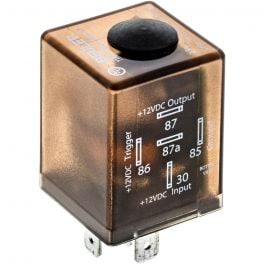Holy Jesus how did I miss this clusterfk....
Use time delay relays on your fans so they run for a couple minutes after you turn the engine off.
Standard automotive style relayAdjustable time delay off with 2 seconds to 3 minutes timer with internal potentiometer20 amp / 30 amp rated contactsSPDT - Single pole Dual throwLow 1volt (1k Ohm) trigger voltage

www.qualitymobilevideo.com
Tell me what that will do besides just cool the coolant in the Radiator and drain the battery..
I'm going to do my best to apply what I know of thermodynamics, physics, and common sense to un-potato this mess. Sheesh..
Hi, im Jaden and own a 82 Monte Carlo.
...but after turning off the car and letting it sit for more then a minute the temp rises pretty quickly to around 230~ while the car is off. When you go to fire up the car after letting it sit for a few minutes it cranks for about 15 seconds, maybe more, and once it finally starts it dumps raw fuel causing white smoke and runs flooded for about a minute or two until it clears up and goes back to normal.
Hi Jaden.
My question on this is how are you seeing this quick of a temp rise? Turning the key on and seeing the temp gauge spiked that high within a minute? If it's dumping that much gas before firing there is an ignition issue so it may be a bad coil or ICM. You have the gas, you lack the spark.
It has a Cold Case large 2 row radiator with dual electric 12" fans, stock water pump, and no thermostat currently. I have been dailying this car for weeks and am sick of this issue and the car running hot in general. Today while driving the temperature reached up to 200F which is strange because it doesnt even get above 190 while driving at all.
That is not hot, at all. You get into the 215 range then worry.
My dad has owned multiple gbodys and classics in general and we are stumped on this issue. Any and all help is appreciated, i will answer any questions in hopes of curing this heat soak/overheating!
Heat soak and over heating are two very different things. If the car runs at 200 at most, it's not over heating.
Parked sitting still with no air moving through the engine bay, hottest part is anything exhaust so that heat will dissipate all over the engine bay until it all cools off. That is heat soak.
Also, the car has had the rear end swapped from its stock low 2.41 ratio gears to what I thought was 3.73 gears with a posi but the car tops out at 50-55, im thinking the rear end may be closer to 4.10 gears or even 4.56s, will gears this high cause overheating due to higher rpm from the gears? Edit: I forgot to mention that you can hear the gas in the carburetor boiling away and after a little bit of time the fuel filter is completely empty. I have yet to see if the carburetor spacer affects this.
Higher RPM will generate more heat, yes. That much heat in the engine bay seems to be a lot and you are getting vapor lock if it's boiling gas off in the lines. Others can chime in here to help remedy that with some tricks, my stuff is all EFI.
Just trying to help with the above, the Radiator is not the issue here...


